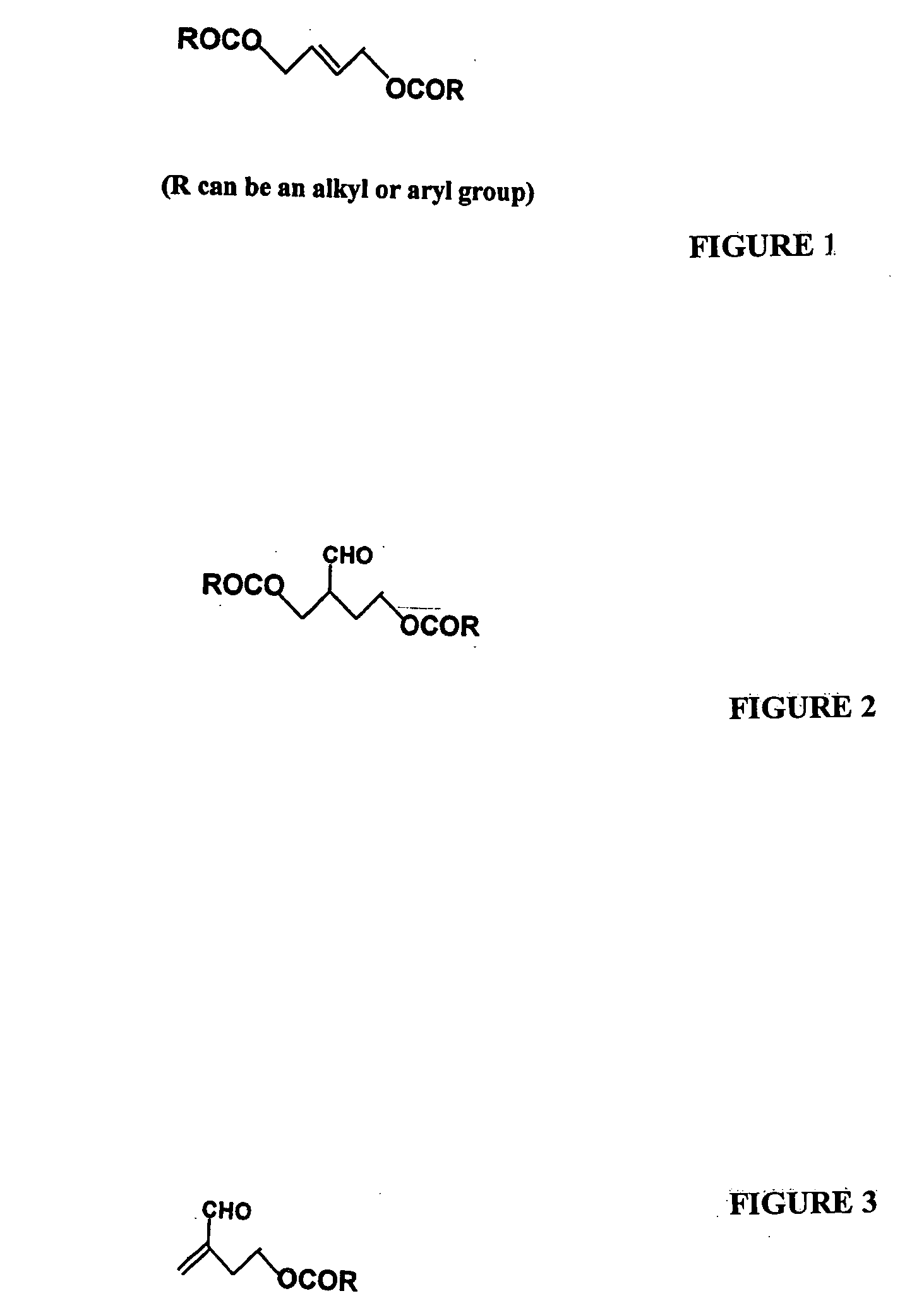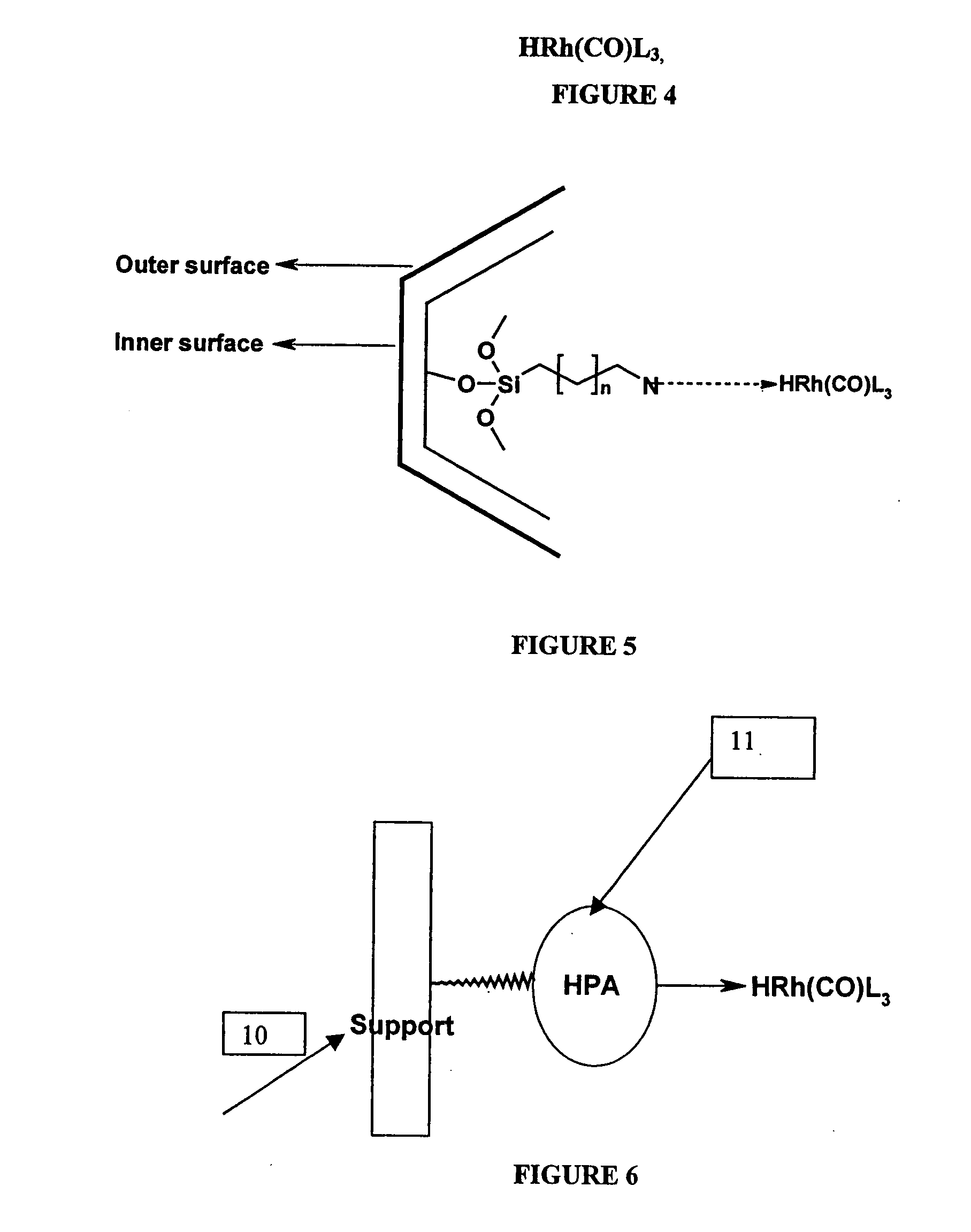Process for preparation of esters of hydroxy tiglic aldehydes
a technology of tiglic aldehyde and esters, which is applied in the preparation of carboxylic acid esters, chemistry apparatus and processes, and organic chemistry, etc. it can solve the problems of harmful gases used in -hydroxy tiglic aldehyde, high temperature and pressure, and high cost of handling procedures, so as to achieve stable form, easy catalyst separation, and high selectivity
- Summary
- Abstract
- Description
- Claims
- Application Information
AI Technical Summary
Benefits of technology
Problems solved by technology
Method used
Image
Examples
example 1
[0047] A solution of 1,4-diacetoxy-2-butene (0.5 g) and HRh(CO)(PPh3)3-entrapped in Zeolite-Y (0.05 g) in toluene (25 ml) was heated in an autoclave at 75° C., under 1000 psig of synthesis gas (50% by volume H2 and 50% by volume CO gas). The reaction was monitored for gas absorption. After the theoretical amount of gas absorption (44 psig) took place and consequently there was no further gas uptake, the reaction was stopped and then the autoclave was cooled to room temperature. The solid catalyst was recovered by decantation of the reaction mixture. The reaction mixture was analyzed by HP 6890 gas chromatograph to give pure 2-Formyl-4-acetoxybutene (99.9% yield and 100% selectivity to 2-Formyl-4-acetoxybutene). Later toluene was removed from the reaction mixture by distillation to get the pure fraction of 2-Formyl-4-acetoxybutene (b.p. 78-79° C. / 5 mm Hg). The recovered catalyst was recycled six times. It was found that there was no losses in activity upon each recycle. ICP analysis ...
example 2
[0048] A solution of 1,4-diacetoxy-2-butene (0.5 g) and HRh(CO)(PPh3)3-tethered on Zeolite-Y (0.05 g) in toluene (25 ml) was heated in an autoclave at 85° C., under 1200 psig of synthesis gas (50% by volume H2 and 50% by volume CO gas). The reaction was monitored for gas absorption. After the theoretical amount of gas absorption (44 psig) took place and consequently there was no further gas uptake, the reaction was stopped and then the autoclave was cooled to room temperature. The solid catalyst was recovered by decantation of the reaction mixture. The reaction mixture was analyzed by HP 6890 gas chromatograph to give pure 2-Formyl-4-acetoxybutene (99.9% yield and 100% selectivity to 2-Formyl-4-acetoxybutene). Later toluene was removed from the reaction mixture by distillation to get the pure fraction of 2-Formyl-4-acetoxybutene (b.p. 78-79° C. / 5 mm Hg). The recovered catalyst was recycled five times. It was found that there was no loss in activity upon each recycle. ICP analysis al...
example 3
[0049] A solution of 1,4-diacetoxy-2-butene (0.5 g) and HRh(CO)(PPh3)3-anchored in MCM-41 (0.05 g) in toluene (25 ml) was heated in an autoclave at 75° C., under 1000 psig of synthesis gas (50% by volume H2 and 50% by volume CO gas). The reaction was monitored for gas absorption. After the theoretical amount of gas absorption (44 psig) took place and consequently there was no further gas uptake, the reaction was stopped and then the autoclave was cooled to room temperature. The solid catalyst was recovered by decantation of the reaction mixture. The reaction mixture was analyzed by HP 6890 gas chromatograph to give pure 2-Formyl-4-acetoxybutene (99.9% yield and 100% selectivity to 2-Formyl-4-acetoxybutene). Later toluene was removed from the reaction mixture by distillation to get the pure fraction of 2-Formyl-4-acetoxybutene (b.p. 78-79° C. / 5 mm Hg). The recovered catalyst was recycled five times. It was found that there was no loss in activity upon each recycle. ICP analysis also ...
PUM
| Property | Measurement | Unit |
|---|---|---|
| pressure | aaaaa | aaaaa |
| pressure | aaaaa | aaaaa |
| pressure | aaaaa | aaaaa |
Abstract
Description
Claims
Application Information
 Login to View More
Login to View More - R&D
- Intellectual Property
- Life Sciences
- Materials
- Tech Scout
- Unparalleled Data Quality
- Higher Quality Content
- 60% Fewer Hallucinations
Browse by: Latest US Patents, China's latest patents, Technical Efficacy Thesaurus, Application Domain, Technology Topic, Popular Technical Reports.
© 2025 PatSnap. All rights reserved.Legal|Privacy policy|Modern Slavery Act Transparency Statement|Sitemap|About US| Contact US: help@patsnap.com



